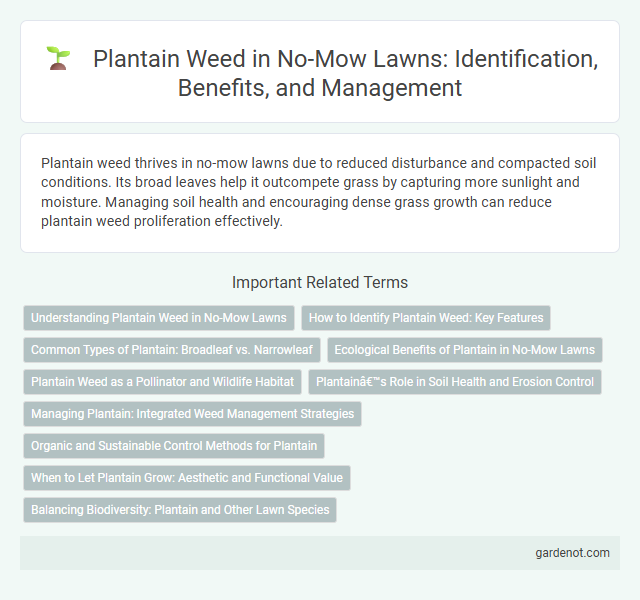Plantain weed thrives in no-mow lawns due to reduced disturbance and compacted soil conditions. Its broad leaves help it outcompete grass by capturing more sunlight and moisture. Managing soil health and encouraging dense grass growth can reduce plantain weed proliferation effectively.
Understanding Plantain Weed in No-Mow Lawns
Plantain weed thrives in no-mow lawns due to its low-growing rosette structure and ability to tolerate minimal disturbance. This weed's broad, flat leaves compete for sunlight and nutrients, often outpacing traditional grass species in these conditions. Managing plantain in no-mow lawns requires targeted strategies such as selective herbicides and maintaining soil health to reduce its spread.
How to Identify Plantain Weed: Key Features
Plantain weed has broad, oval-shaped leaves with prominent parallel veins that radiate from the base, forming a rosette pattern close to the ground. The leaf edges are smooth or slightly wavy, and the plant produces long, slender flower spikes with small greenish-brown flowers. Identifying these key features helps distinguish plantain weed from grass and other common lawn weeds in no-mow lawn settings.
Common Types of Plantain: Broadleaf vs. Narrowleaf
Broadleaf plantain (Plantago major) features wide, oval-shaped leaves with prominent veins, commonly found in compacted soils and lawns requiring minimal maintenance. Narrowleaf plantain (Plantago lanceolata) has long, slender leaves with finer veins and thrives in well-drained, less disturbed areas, offering resilience in no-mow lawn settings. Both species are low-growing, drought-tolerant perennials that contribute to soil erosion control and support pollinators, making them valuable components of sustainable, low-maintenance turf ecosystems.
Ecological Benefits of Plantain in No-Mow Lawns
Plantain weed contributes significantly to soil health in no-mow lawns by enhancing nutrient cycling and improving soil structure with its deep root system. This resilient plant supports pollinators such as bees and butterflies by providing nectar and pollen throughout the growing season. Its ability to tolerate compaction and drought conditions makes plantain an ecologically valuable species for sustainable, low-maintenance lawn ecosystems.
Plantain Weed as a Pollinator and Wildlife Habitat
Plantain weed serves as an important pollinator-friendly plant, attracting bees, butterflies, and other beneficial insects critical for ecosystem health. Its broad leaves provide shelter and habitat for small wildlife, including ground-nesting birds and insects, enhancing biodiversity in no-mow lawn settings. Integrating plantain weed into no-mow lawns supports natural pest control and promotes a balanced, sustainable urban ecosystem.
Plantain’s Role in Soil Health and Erosion Control
Plantain weed (Plantago major) contributes significantly to soil health by enhancing organic matter and supporting beneficial microbial activity. Its deep roots improve soil structure, increasing water retention and reducing surface runoff. This natural erosion control helps stabilize no-mow lawns, promoting sustainable ground cover without the need for frequent mowing.
Managing Plantain: Integrated Weed Management Strategies
Managing plantain weed in no-mow lawns requires integrated weed management strategies that combine cultural, mechanical, and biological controls. Regular monitoring to identify early infestations allows for timely spot treatments using targeted herbicides or manual removal to prevent spread. Promoting dense turf growth through proper soil conditioning and overseeding can suppress plantain establishment by outcompeting the weed.
Organic and Sustainable Control Methods for Plantain
Organic and sustainable control methods for plantain weed in no-mow lawns include hand-pulling before seed set to prevent spread and applying organic mulch to suppress germination. Incorporating ground covers such as clover enhances soil health and outcompetes plantain without chemical inputs. Maintaining proper soil fertility and mowing height supports dense turfgrass growth, reducing plantain establishment naturally.
When to Let Plantain Grow: Aesthetic and Functional Value
Allowing plantain to grow in no-mow lawns enhances soil health by reducing erosion and improving nutrient cycling. Its broad leaves provide ground cover that supports pollinators and beneficial insects, contributing to local biodiversity. Plantain's low height and resilience maintain an attractive, functional landscape without frequent mowing.
Balancing Biodiversity: Plantain and Other Lawn Species
Plantain (Plantago major) plays a vital role in balancing biodiversity within no-mow lawns by providing ground cover that supports pollinators and beneficial insects. Integrating plantain with other lawn species such as clover and native grasses creates a resilient ecosystem that requires minimal maintenance and reduces chemical inputs. This biodiversity enhances soil health, promotes natural pest control, and contributes to a sustainable, eco-friendly landscape.
Plantain weed Infographic

 gardenot.com
gardenot.com